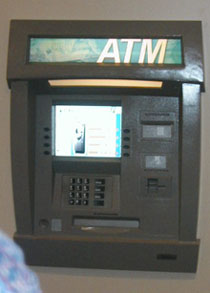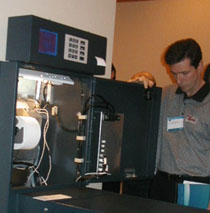News
Triton refines the product rollout
Shortening its development cycle helped Triton enjoy its most successful product launch ever with the 9100 at its 2002 Distributor Conference. The manufacturer hopes to duplicate that success with the two new models it rolled out earlier this week at this year's conference.
April 10, 2003
BILOXI, Miss. -- Triton enjoyed its most successful product launch ever at last year's Distributor Conference by showing it could deliver the goods -- and fast.
Bill Jackson, the manufacturer's chief technical officer, speaking to 179 attendees at this year's conference, said that prior to 2002 a typical Triton product introduction involved "showing you pictures, then concepts and actually delivering the product three years later."
Faced with a fiercely competitive retail ATM market and encouraged by its parent company, Dover Corporation, to streamline its development process, Triton changed all that in 2002.
Its lowest-cost ATM, the 9100, was already in beta tests by the time distributors first saw it at last year's conference. It began shipping within weeks. (See related story Triton picks up the production pace)
The result: more than 8,500 units sold in the first 10 months of the machine's life. Jackson said the company expects to have at least 10,000 in the ground when the 9100 marks its first anniversary next month.
Triton adopted a "build to stock" philosophy with the 9100, offering its dealers only one configuration when it was introduced and adding just a few more options -- color screen, electronic lock, audio capability and De La Rue MiniMech dispenser -- last October.
With just three configurations available, Jackson said, "If you order a 9100 by 2 p.m., we can have it in your hands the next day if you think you need it."
The middle class
Triton hopes to duplicate that success with the two new models it rolled out at this year's Distributor Conference, held at the Palace Casino Resort. Unlike the 9100, however, the newest units are pricier models that Triton is targeting for a different -- and somewhat tricky -- market segment.
 |
Triton's new FT5000, its first through-the-wall unit, from the front... |
"We're pretty determined to move into that middle range," said Brian Kett, the company's newly named president.
He added that Triton expects to introduce new products every year -- services and applications, as well as hardware. Two new releases are planned for this year's NACS (National Association of Convenience Stores) Show, slated for October in Chicago.
Kett said that new software applications such as those offered through Triton's Waves program will add value for the machines' owners and managers and may help expand the core group of off-premise ATM users, which he estimated at about 25 percent of the existing card base.
Kett succeeds Ernest Burdette, one of the company's three original founders. Based on his introductions of Kett and other new members of the management team, Burdette seems to be enjoying his new role as president emeritus. After joking that he recently discovered that "emeritus" was the Latin term for "very old," Burdette said his duties now largely involve making calls on business partners.
After a brief chronology of the Triton product line, Jackson dropped two drapes to reveal the RL5000, a walk-up unit, and the FT5000, the company's first through-the-wall machine. The build-up appeared to have the desired effect on the ISOs in attendance, many of whom flocked to the front of the room to check out the machines rather than wait for a later session in a demonstration area.
What's new
Both are PC-based, featuring an Intel Xscale 32-byte microprocessor running a Microsoft Windows CE operating system. Triton built its own electronics rather than using its more typical off-the-shelf components. This was largely to avoid the possible future obsolescence of critical parts, Jackson said.
Both ATMs have 80-millimeter thermal printers, which print receipts that are 33 percent larger than those produced by the 60-millimeter printers used in other Triton machines; Jackson showed a slide that illustrated the difference. The printers support full-color graphics, multiple fonts and bar codes.
The ATMs have an Ethernet interface to support TCP/IP, a form of telecommunications that is gaining popularity among both financial institutions and large retail chains, the two audiences Triton is trying to reach.
Other options that Triton believes will likely appeal to those markets are a Level 1 vault and a choice of dispensing mechanisms, including De La Rue's NMD100. Already slated for future versions of the FT5000 are a motorized card reader and metal bezel and keycaps, options aimed at non-domestic markets such as the UK, Jackson said.
Banks on board?
Triton believes that now, two years before MasterCard's deadline for Triple DES compliance, may be the ideal time to approach financial institutions that are faced with decisions over whether to buy new hardware or invest in costly upgrades to their aging ATMs.
To make the offer a compelling one, Triton's suggested retail price for the FT5000 is about a third less than the cost of most existing through-the-wall bank machines. At that price, said Doug Sholes, Triton's newly appointed manager of financial institution sales, resellers will still make "a significant margin."
 |
...and a back view. |
Rather than relying exclusively on its existing sales channel, Sholes said Triton is also recruiting VARs, or value-added resellers. Like the more traditional bank-oriented manufacturers, Triton expects to find VARs among companies that already serve financial institutions, such as refurb shops.
Triton is particularly interested in Texas, California and the Northeastern seaboard, Sholes said, because there are large concentrations of the credit unions and community banks that Triton sees as its most logical entry into the financial institution market.
Future models geared toward the retail market will bear an "R" as in the RL5000, Kett explained, while those designed with financial institutions in mind will have an "F."
Aesthetically, the RL5000's cabinet possesses the same footprint and curvy shape as Triton's 9700. The cabinets are a new understated hue, which Jackson dubbed Bayou Bronze.
Andy King, director of business development for the UK-based ISO InfoCash, believed that most Brits would like the new color.
"It's not as boring as the (beige) 9600 and not as distinctive as the (bright blue) 9700," King said. "In the UK, I think people are more bothered about what their ATMs look like and more likely to reject an ATM on looks alone. In the States, they couldn't give a toss as long as it's cheap."
Both models feature bright green lead-through indicators, the flashing lights that guide users to the card reader, dispenser and printer during the appropriate parts of the transaction. While a common feature on higher-end bank ATMs, the indicators are not typically found in the retail world. At 10.4 inches, their high-resolution color screens are nearly twice as large as the six-inch displays found on most retail ATMs.
According to Jackson, the RL5000 will be in beta tests next month, with full production expected to begin in July. The FT5000 will also be in betas next month, with production slated for August.
Included In This Story
Triton Systems
Triton FI based products • NO Windows 10™ Upgrade • Secured locked down system that is virus/malware resistant • Flexible configurations - Drive-up and Walk-up • Triton's high security standards • NFC, anti-skim card reader, IP camera and level 1 vaults are all options • Triton Connect monitoring • Lower cost









